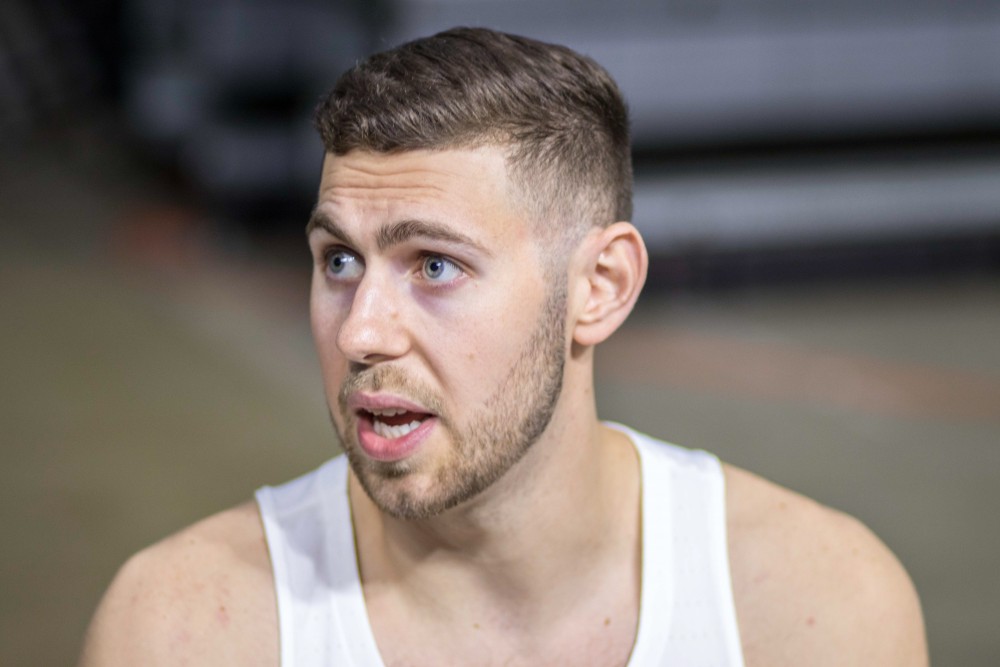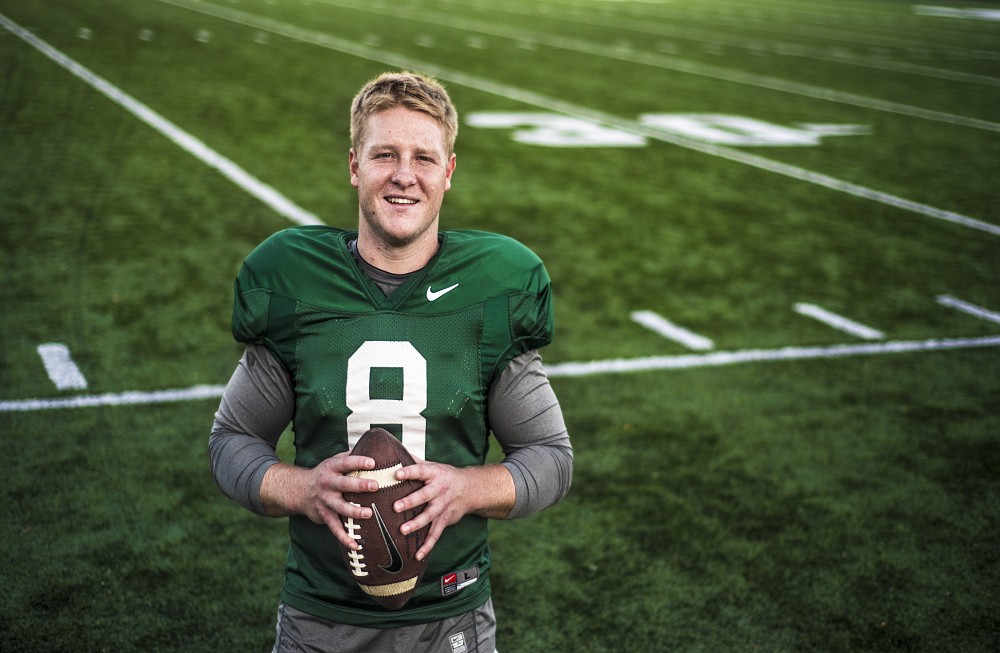“Transfer athletes work to impress, leave mark at MSU”
Article By Jameson Draper
Photos By Carly Geraci
The classic college athletics experience starts with walking on campus day one, learning the ropes and eventually becoming a seasoned resident of the university.
You grind on the field and in practice for years, cementing yourself as a campus mainstay. You stay there for four or five years, then maybe go on to something greater.
But for some, adjusting to college athletics isn’t that simple.
Some students never find their footing at their initial landing spots. After months — or maybe even years — of deliberation, students may decide the current institution they’re attending isn’t for them.
They decide to play their sport at another university.
Whether it’s campus size, athletic playing time or location, every student that transfers has a their own reason.
Starting the process
“I wanted to try to come back closer to home," sophomore center Braden Burke said. "And then when I got the opportunity to be a scholarship player at a mid-major close to home or come here, I chose to come here for the chance to play at the highest level.”
Burke, a transfer from Robert Morris University, is from Stevensville, Michigan. He committed to the MSU basketball team in May after one season with the Colonials.
✳️ I am extremely excited to announce that I have committed to Michigan State University ✳️ #SpartanDawg pic.twitter.com/7w1VsLjukt
— Braden Burke (@BradenBurke_) May 11, 2017
Like Burke, other transfer athletes come to MSU for the prestige of the program.
“This place is special,” said sixth-year senior transfer Ben Carter, also a center for the MSU hoops team. “I wanted something more out of my college career and I knew that coming here I would have an opportunity to get what I wanted in terms of playing at the highest level. Playing for a Hall of Fame coach and having a chance to be a champion.”
The transfer process in the NCAA is hellacious. If a student is transferring from a four-year university, he or she must sit out the first season, only attending school as a student.
Students don’t have to give up a year of eligibility, though. They have to meet three criteria to be exempted from the sitting out rule: they need to have played for a Division I school previously that did not offer you a scholarship, they must be athletically and academically eligible at their previous school and they must receive a transfer-release agreement from the previous school.
There are also waivers that can be handed out because of a “specific, extraordinary circumstance” that stops them from meeting the rules and exempts them from sitting out. That’s a rarity, so most players take a year off when transferring.
Some players transfer multiple times — Carter transferred twice. He started his career at Oregon University, then moved to the University of Nevada-Las Vegas. After missing significant time at UNLV because of an injury, he transferred to MSU, where he sustained an injury during his first practice that sidelined him for the entire 2016-2017 season.
If anyone knows about the transfer process, it’s Carter.

“I don’t see it as a negative," he said. "People might say, ‘Oh, this kid transferred twice.’ They might look at my character and might look at my personality. Me personally, I don’t care. I don’t care how people view me because those who know me know what kind of person I am. I can’t say a bad thing about my transfer experiences because I only see positives.”
Support from the team
One of the most helpful things any student-athlete can do for new transfers is show hospitality. Accommodating new players can be hard, as you already have a tight-knit team and you don’t want to ruin the chemistry. But ignoring the new players isn’t the route MSU takes.
“I don’t see it as a negative. People might say, ‘Oh, this kid transferred twice.’ They might look at my character and might look at my personality. Me personally, I don’t care. I don’t care how people view me because those who know me know what kind of person I am. I can’t say a bad thing about my transfer experiences because I only see positives."
“Transfer or not transfer, any of the guys we treat all the same,” junior punter Jake Hartbarger for said. “Guys that have been here for a few years can teach the younger guys and anyone that needs help.”
For Burke, the hospitality has been noticeable.
“I love my teammates here,” said Burke. “Everyone’s just so welcoming. Everyone’s helpful. Everyone’s really encouraging. It’s a great place to be.”
Some veteran players even take the hospitality further. Sophomore forward Miles Bridges said he acts as a mentor to some transfer athletes.
“Just like Jaren, I like to take (Burke) under my wing too,” Bridges said. “I mean, he has a year under his belt, but I still want to show him the ropes because he was at a mid-major.”
Brett Scanlon, a fifth-year senior kickoff specialist on the football team, started his career at Western Michigan. He played two seasons in Kalamazoo before transferring to play for the Spartans.

“One thing I told my parents and friends from back home is that I think the coaching staff and just the team in general, they made it really easy to come right in and mesh right away,” Scanlon said. “You don’t see that at every football program, so that was really neat just coming to a place with a family atmosphere.”
Working for the rules
Transferring can be a worrisome process. There are many factors involved and a lot of uncertainty to go along with it.
So what’s the worst part?
Burke said it's making the decision alone.
“Initially, just not knowing where you’re going to end up. Obviously, you’re not allowed to talk to anyone,” he said, acknowledging that contact with other coaches while deciding to transfer is prohibited.
Per NCAA rules, student-athletes have to get written permission from the athletic director of their school before contacting another institution.
“So I transferred and given the opportunity, I could end up nowhere," Burke said. "No coaches could call me. I could end up having to go to a (junior college) or something like that. Everything’s up in the air. There’s no guarantees.”
For Scanlon, the hardest part was waiting to play. The NCAA rule delaying eligibility is to encourage students to transfer for academic reasons, too. Still, Scanlon said he couldn't wait to get on the field again.
“I think the hardest part for me was just being out of football for about half of a year. It was different. I was so used to playing football every Friday or Saturday night,” he said. “For that half of a year I wasn’t doing anything, just working out on my own, kicking on my own.”
Some student-athletes chose MSU despite not having a scholarship. Burke had a scholarship at Robert Morris, and is sitting out this year as a walk-on. Scanlon had a scholarship at Western Michigan and transferred to MSU as a walk-on before receiving a scholarship.
“Everyone’s really helpful,” Burke said. “There’s so many guys on the team with experience. Ben has transferred a couple times. He’s been really helpful in the process. Guys like Kenny (Goins) who have been in my position, he was a walk on at once and then won a scholarship, which is what I’m trying to do.”
"No coaches could call me. I could end up having to go to a (junior college) or something like that. Everything’s up in the air. There’s no guarantees.”
Goins, a redshirt junior forward, said transfers and walk-ons looking to get a scholarship have to put in extra work to get a scholarship.
“Do all the little things right and always go hard,” he said. “Because when it comes down to it, they’re looking for people to mess up, realistically. When you have as much talent as you have on this team, it’s like who’s going to mess up the least are the people that’s going to play, you know? And as a walk-on, everything is magnified for you. Because you can’t screw up in drills. You can’t screw up the little defensive assignments.”
All hope is not lost, though. Transfer walk-ons, like Scanlon and Burke, can still get offered scholarships if their play warrants it.
“(Burke) is a solid player,” said Bridges. “I feel like he’s going to have a scholarship soon.”